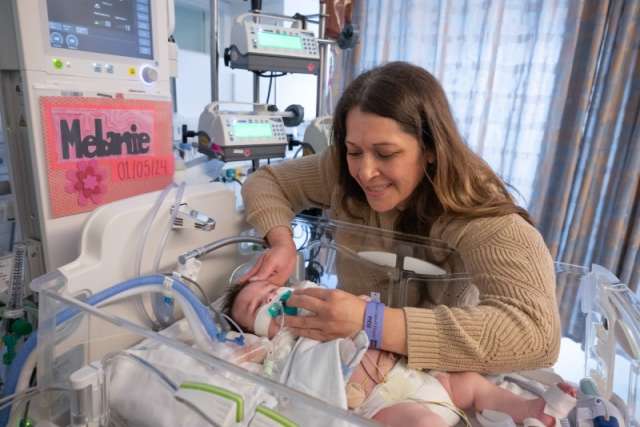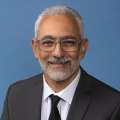In the days leading up to the New Year, Irene Rodriguez and her unborn daughter faced an urgent challenge that demanded a complex medical response at UCLA Health.
An MRI disclosed that Rodriguez’s child had a large mass on her neck that, once the baby was delivered, might interfere with her ability to breathe independently. Her doctors referred her case to UCLA.
To correct the condition and safely deliver the baby, who Rodriguez would name Melanie, a multidisciplinary team of UCLA Health physicians assembled to perform a rare operation called an ex-utero intrapartum treatment, or EXIT. It was the first successful EXIT procedure performed at UCLA.
While in the womb, the baby receives nutrients and oxygen via the placenta; after delivery and the umbilical cord is cut, the baby’s lungs must take over. In a case such as Rodriguez’s, the EXIT procedure allows the baby to be partially delivered and the baby’s airway to be secured while still on placental support before separating the baby from the placenta and its oxygen supply.
“These are rare cases which require a multidisciplinary team approach to ensure successful delivery of the baby,” said Sohit Paul Kanotra, MD, a pediatric otolaryngologist and director of the Complex Pediatric Airway program who had come to UCLA Health just three months before and had prior extensive experience with the EXIT procedure. “The child had a distorted airway because of the neck mass compressing her windpipe. We wanted more time to secure the airway, so we had to keep the baby connected to the mother’s oxygen supply through the placenta.”
If the oxygen supply to the baby had been lost, it could have led to irreversible brain damage, explained Suhas Kallapur, MD, chief of neonatology at UCLA Mattel Children’s Hospital. “We had to make sure we didn’t lose connection with the placenta when we went in to secure the airway,” he said.
The procedure was not without complications. The team ran into two hurdles during Rodriguez’s treatment.
“Irene had polyhydramnios” — too much amniotic fluid around the baby in the womb — “and that made the procedure a little complicated,” said Ilina Pluym, MD, an obstetrician and gynecologist at UCLA Health. “She also had a lot of bleeding. We had to get creative and use a special type of stapler to control the bleeding, which was really tricky. But it turned out fine.”
The surgery was performed a few days after the New Year. “We were able to secure the airway and the baby was delivered,” said Dr. Kanotra.
The operation reflected a coordinated, full-court team effort, involving physicians from obstetrics and gynecology, pediatric surgery, pediatric head and neck surgery, obstetric and pediatric anesthesiology, neonatology, radiology and the NICU. “The teamwork was great between all of us,” Ihab Ayad, MD, chief of pediatric anesthesia at UCLA Mattel Children's Hospital. “Everyone in the operating room performed their duties, and we all trusted each other.”
Said Daniel DeUgarte, MD, clinical professor of pediatric surgery, “Everyone was just superb. Getting everybody together and executing this was critical, and the fact that we did it on such short notice shows the commitment and excellence of our physicians here.”
Though somewhat overwhelmed by how quickly things developed, Rodriguez was filled with praise for the UCLA team’s dedication and expertise. “It was a little nerve-wracking because everything happened so fast, and you don’t really know what’s going on,” she said. And she was concerned that because it was so close to the New Year that many doctors would be away when she went into labor. She says she was deeply moved by the commitment of the UCLA doctors who sacrificed their holiday time to ensure her and her baby’s well-being.








